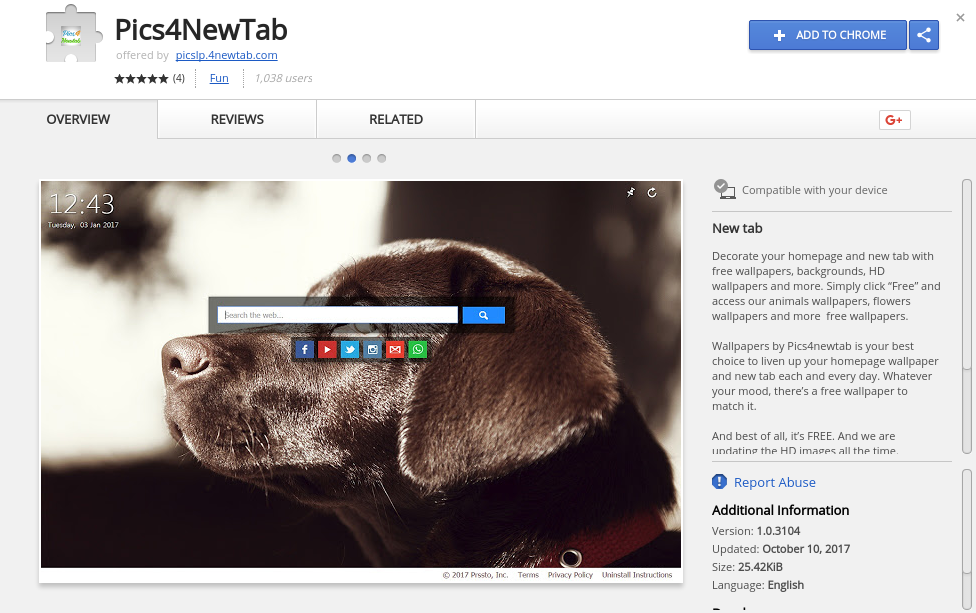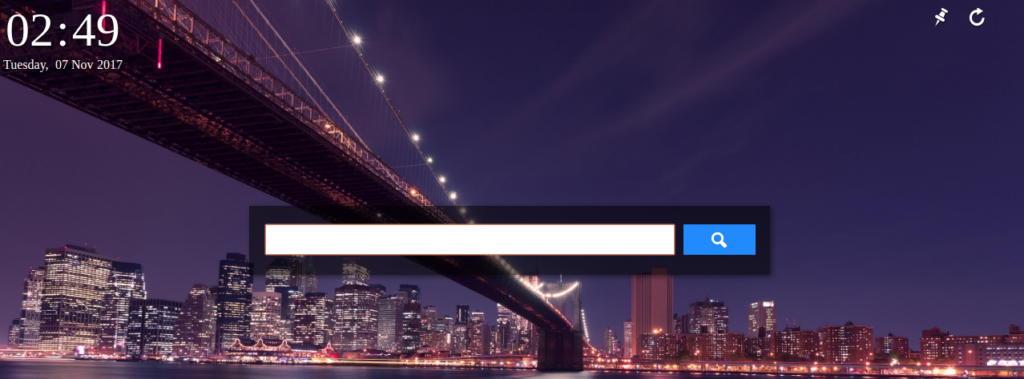An infection with the dangerous Pics4NewTab Redirect leads to serious security issues. Victims can restore and protect their computers by following our complete removal guide.
Remove Pics4NewTab Redirect and Restore PC
Manual Removal Guide
Skip all steps and download anti-malware tool that will safely scan and clean your PC.
SpyHunter anti-malware tool will diagnose all current threats on the computer. By purchasing the full version, you will be able to remove all malware threats instantly. Additional information about SpyHunter / Help to uninstall SpyHunter
Distribution of Pics4NewTab Redirect
Pics4NewTab is a new malware which has been reported in various attacks worldwide. At the moment the security experts have not been able to identify a single tactic that is being used to infect the targets. We presume that the hackers are using several of the most important methods to carry out the malicious campaigns.
A common way of setting browser hijacker attacks is the use of email spam messages. They may directly distribute malicious file attachments containing scripts that lead to an infection. Other cases can utilize complex social engineering tricks and hyperlinks that are specifically made to confuse the intended targets into infecting themselves. Two more scenarios that are used in combination with email messages rely on infected files used as payloads ‒ documents and software installers.
- Infected Software Installers ‒ The criminals craft malicious packages made out of legitimate software installers. They are taken from the official vendor download sites, modified and then posted on online sites or attached (either as file attachments) or linked in the email messages.
- Infected Documents ‒ They represent dangerous files that usually come in the form of some of the most popular document types: rich text documents, spreadsheets and databases. When the users open them up a notification prompt will ask them to enable the built-in scripts (macros). If this is done then the malware is installed on the victim computer.
The malware browser plugins can be uploaded to hacker-controlled sites and P2P networks like BitTorrent as well. The hacker operators frequently utilize template design, text and images to create portals that look like legitimate download sources. They may also use domain names that are very similar to legitimate sites and advertise them via pop-ups or ad networks.
The browser hijacker code associated with the Pics4NewTab Redirect can be found in numerous malware toolbars. They are usually made for the most popular web browsers: Mozilla Firefox, Google Chrome, Internet Explorer, Safari, Microsoft Edge. They can be distributed on such download sites or even on the browsers repositories (such as the Chrome Web Store for Google Chrome) using fake developer accounts.
One of the leading infection causes that lead to the distribution of the Pics4NewTab hijacker is an activel instance on the Chrome Web Store. It has been setup by the operators of the site and features images and text that aim to make more people install the extension.
Its description reads the following:
New tab
Decorate your homepage and new tab with free wallpapers, backgrounds, HD wallpapers and more. Simply click “Free” and access our animals wallpapers, flowers wallpapers and more free wallpapers.Wallpapers by Pics4newtab is your best choice to liven up your homepage wallpaper and new tab each and every day. Whatever your mood, there’s a free wallpaper to match it.
And best of all, it’s FREE. And we are updating the HD images all the time.
This extension will set www.4newtab.com/pics as your new tab page.
allowing you to enjoy a variety of lovely backgrounds images on your new tab page

The latest version is numbered as Version: 1.0.3104 and the instance has been last updated on October 10 2017.
Impact of Pics4NewTab Redirect
Once the users get infected with the Pics4NewTab redirect their default home page, search engine and new tabs page will be changed to a hacker-operated site. Depending on the strain there may be different addresses. All of them institute dangerous tracking cookies which are used to capture the behavior of the victims and harvest their personal information. When the users install the Pics4NewTab Redirect browser hijacker they are offered an additional browser extension as part of the infection process. When the users go through the infections they are redirected to a site that looks like a ordinary search engine.

The victims should know that any use of the site will lead to information tracking and surveillance from the operators.
We remind our users that the Pics4NewTab browser hijacker code can be used to to install additional malware on the compromised machines. One of the addresses shows a large banner text which reads the following when users visit the site without having the hijacker installed. It shows the following message:
Get FREE Amazing Pics Every
Time You Open A New Tab in
Google Chrome.
Hand picked images just for you,
redesign your browser.Customize your New Tab page with
Beautiful images and wallpapers.
Another address shows just a “Coming Soon” page with no information on the hijacker. The EULA and the privacy policy lists some of the main concerns when it comes to the security and privacy risks:
- Automatic Data Collection ‒ The threat automatically collects data using the browser extension. The documents note that the following types of information are automatically sent to the operators: IP address, browser type, regional settings and language options, access times, content of undeleted cookies, connected devices and referring sites.
- Cookies Installation ‒ Various cookies are enforced on the computer which use the extracted information to “personalize” the search results. They are used to extract more data and display ads and links to the users which may be more interesting to them.
- Ads and Beacons ‒ As part of the users tracking initiative the operators can also use ads and web beacons as they browser the site.
- Third Party Data Sharing ‒ The operators of the Pics4NewTab redirect have the ability to share the collected information on the users with other network partners or third parties.
These are the main reasons why we recommend that all victims remove the active infections by following our in-depth removal guide.
Remove Pics4NewTab Redirect and Restore PC
WARNING! Manual removal of the Pics4NewTab Redirect requires being familiar with system files and registries. Removing important data accidentally can lead to permanent system damage. If you don’t feel comfortable with manual instructions, download a powerful anti-malware tool that will scan your system for malware and clean it safely for you.
SpyHunter anti-malware tool will diagnose all current threats on the computer. By purchasing the full version, you will be able to remove all malware threats instantly. Additional information about SpyHunter / Help to uninstall SpyHunter
Pics4NewTab Redirect – Manual Removal Steps
Start the PC in Safe Mode with Network
This will isolate all files and objects created by the ransomware so they will be removed efficiently. The steps bellow are applicable to all Windows versions.
1. Hit the WIN Key + R
2. A Run window will appear. In it, write msconfig and then press Enter
3. A Configuration box shall appear. In it Choose the tab named Boot
4. Mark Safe Boot option and then go to Network under it to tick it too
5. Apply -> OK
Remove Pics4NewTab from Windows
Here’s a way to remove the program. This method will work regardless if you’re on Windows 10, 8, 7, Vista or XP. Simply selecting the program and pressing delete won’t work, as it’ll leave a lot of small files. That’s bad because these leftovers can linger on and cause all sorts of problems. The best way to delete a program is to uninstall it. Here’s how you can do that:
1. Hold the “Windows” button (It’s between CTRL and Alt on most keyboards) and press “R”. You’ll see a pop-up window.

2. In the textbox, type “appwiz.cpl”, then press“ Enter ”.

3. The “Programs and features” menu should now appear. It’s a list of all the programs installed on the PC. Here you can find the program, select it, and press “Uninstall“.

Remove Pics4NewTab Virus From Your Browser
Before resetting your browser’s settings, you should know that this action will wipe out all your recorded usernames, passwords, and other types of data. Make sure to save them in some way.
-
1. Start Mozilla Firefox. In the upper right corner, click on the Open menu icon and select “Add-ons“.

2. Inside the Add-ons Manager select “Extensions“. Search the list of extensions for suspicious entries. If you find any, select them and click “Remove“.

3. Click again on the Open menu icon, then click “Options“.

4. In the Options window, under “General” tab, click “Restore to Default“.

5. Select “Search” in the left menu, mark the unknown search engine and press “Remove”.

-
1. Start Google Chrome. On the upper-right corner, there a “Customize and Control” menu icon. Click on it, then click on “Settings“.

2. Click “Extensions” in the left menu. Then click on the trash bin icon to remove the suspicious extension.

3. Again in the left menu, under Chrome, Click on “Settings“. Go under “On Startup” and set a new page.

4. Afterward, scroll down to “Search“, click on “Manage search engines“.

5. In the default search settings list, find the unknown search engine and click on “X“. Then select your search engine of choice and click “Make default“. When you are ready click “Done” button in the right bottom corner.

2. In the “Manage add-ons” window, bellow “Add-on Types“, select “Toolbars and Extensions“. If you see a suspicious toolbar, select it and click “Remove“.

3. Then again in the “Manage Add-ons” window, in “Add-on Types“, Select “Search Providers“. Chose a search engine and click “Set as default“. Select the unknown search engine and click “Remove and Close”.

4. Open the Tools menu, select “Internet Options”.

5. In the “General” tab, in “Home page”, enter your preferred page. Click “Apply” and “OK”.

Repair Windows Registry
1. Again type simultaneously the WIN Key + R key combination
2. In the box, write regedit and hit Enter
3. Type the CTRL+ F and then write the malicious name in the search type field to locate the malicious executable
4. In case you have discovered registry keys and values related to the name, you should delete them, but be careful not to delete legitimate keys
Click for more information about Windows Registry and further repair help



